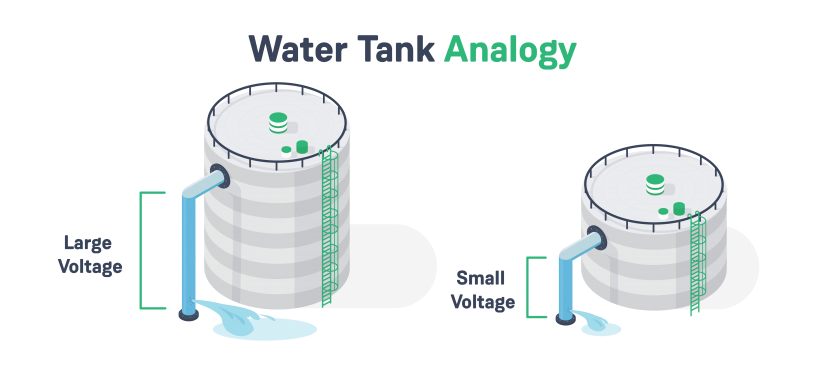What is Voltage?
Voltage is a term that we have all come across at some point. An AA battery has a voltage of 1.5 volts (V) while a smoke alarm battery has a voltage of 9V. We also know that mains electricity, or household electricity, is 230V while the voltage carried by large transmission lines is well over 250 kilovolts (KV)! From this, we can conclude that low voltages such as those from batteries are harmless while larger voltage can be dangerous. But what exactly IS voltage and how does it relate to circuits? Learn all about voltage, from what is voltage and a voltage definition to looking at voltage symbols, equations, and more!
What is Voltage? Voltage Definition, Potential Difference, and More
In short, voltage can be thought of as a force that “pulls electricity” around a circuit. If a larger voltage is applied to a circuit, then it will experience a larger flow of electricity (i.e. current). If a smaller voltage is applied to a circuit, then it will experience a smaller flow of electricity. A good analogy for voltage is water pressure. Holding a water tank high off the ground will have water shoot out of the bottom faster than the tank closer to the ground.

But while this analogy is great for learning the very basics of voltage, it does not cover everything. For example, voltages can be positive or negative (i.e. direction which they pull charges). Voltage also comes in two types depending on what is being described. These two types are Electromotive Force (EMF), and potential Difference (PD). When voltage is generated (either by a battery or generator), then the voltage produced is referred to as EMF. When voltage is lost over a component (such as across a heater), then the voltage that is lost is referred to as a potential difference. Potential Difference can be thought of as the loss of the pushing force.

Voltage definition: A force that pulls electricity around a circuit.
What is Potential Difference: Loss of a pushing force.
History of Voltage
Voltage dates back to Alessandro Volta who was responsible for creating the first battery, the voltaic pile. This battery is incredibly simple and can be constructed at home with a few supplies found around the home. The battery is built using alternative layers of copper coins, aluminum, and paper soaked in vinegar all stacked on top of each other. While not a powerful source of electricity, this demonstrated that electricity could be made chemically and experiments with dead frogs demonstrated that nerves used electricity and not some special biological electricity. Alessandro Volta did not coin the term voltage but instead was named after his achievements in the field of science.
Voltage Specifics - Voltage Units and More
Voltage is measured in volts and has the symbol V. While we know that voltage can be thought of as a force that pulls electric charges, we still don’t know exactly what one volt is and how it is defined. The scientific definition of one volt is when one coulomb of charge does 1 joule of work, but when dealing with electronics, this is rarely revisited or even considered. Practical electronics are instead concerned about how to use components.
Voltage, like a force, has a polarity, which means that it can push OR pull on an electric current. Voltage, like a force, is also relative, and the size of a voltage actually depends from where you measure it. When a voltage is measured, we take two points and measure the difference between those two points. So, a 1.5V battery has 1.5V between its terminals if we connect the negative probe to the negative terminal and the positive probe to the positive terminal. If, however, we connect the negative probe to the positive terminal and the positive probe to the negative terminal, we will instead read -1.5V.

Voltage units: Volts
How is Voltage Made?
Remember how we said previously that voltage came in two types? This matters a lot when talking about “making voltage” because when creating electric power, we are in fact creating EMF and NOT potential difference! So, how can we create an EMF? There are a few methods in which an EMF can be produced, including electrochemical, electromechanical, thermal, and solar.
Electrochemical methods are those that include batteries and rely on chemistry to create a potential difference between two terminals. Some batteries are wet and use a liquid as an electrolyte to carry charges between the two terminals while others are dry.

Electromechanical methods are those that use mechanical motion to induce current into a wire using magnetic fields. These are the most common method for electricity generation and can be found in power stations, dynamos, and motors.

Thermal methods rely on dissimilar metals that, when in contact, will produce a voltage across them, and are often referred to as thermocouples. Peltier devices are those that convert a temperature difference between two sides of a special semiconductor into electricity and are commonly found in deep space missions (such as Voyager 1, Voyage 2, and New Horizons).

Solar is mentioned in its own category as light is directly converted into electricity with the help of special semiconductor arrangements. This technology is what makes photovoltaic panels works and is increasingly becoming more popular around the world as a safe source of power.

How Does Voltage Work With Other Voltages?

Voltage is very simple and easy to work with. Voltages in series add up, and voltages in parallel stay the same! A common occurrence in electronics is to get a larger voltage supply than what a single battery can offer. While a larger battery can be chosen, it is often easier to use two identical batteries in series whose voltage adds together. But remember, voltages have a polarity meaning that if a battery is reversed then instead of adding to the overall voltage will instead subtract from it!

When connecting batteries in parallel, it is essential that these batteries are ALL AT THE SAME VOLTAGE! If two dissimilar batteries are connected in parallel, then the larger battery will attempt to push current into the other battery which can cause it to overheat and potentially catch on fire.
Common Examples of Safe Voltage Sources
Voltage sources can be found in so many different places but just because they exist does not mean that you should go and use them! For example, lighting is an incredibly powerful source of electricity, but building a lighting mast and connecting your Arduino to it is probably going to end very badly. The mains power is often a used power source for projects but can also be unsafe to use especially if an isolating transformer is not used. Therefore, always pick a safe source of power using the list below!
- Small solar cell (not the rooftop ones)
- Batteries
- Wall Wart (make sure they are double insulated and isolated)
- USB
Conclusion
Voltage is a fundamental concept in electronics and will probably be the one thing that you look at the most when designing circuits. While the definition of a voltage, one joule per coulomb, will never be looked at or even considered, the fact that voltage has polarity and adds up in series will be!














































Leave your feedback...